














June 10, 2017 | permalink
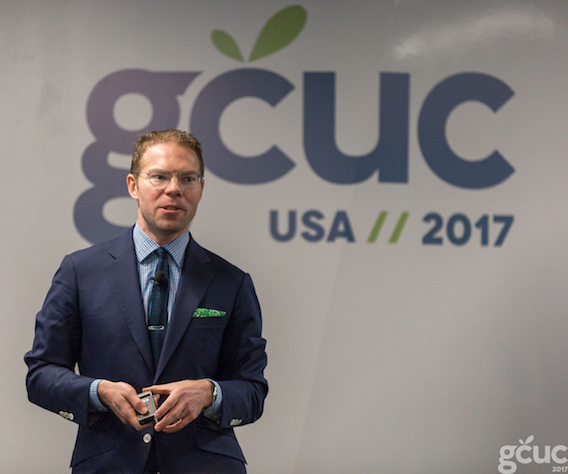
I’m writing this somewhere above the Arctic Circle bound for home after speaking and moderating at my fifth New Cities Summit in Songdo, marking the official start to the summer speaking season.
It’s been a busy spring, however, headlined by delivering the opening keynote at the Global Coworking Unconference (GCUC), where everyone-who’s-everyone in the vanguard of shared workspaces and the future of work assembles to debate the future. Once again, I made the case that the line between the office and the city, and between work and play, is blurring beyond all recognition. “Coworking is eating the world,” I announced, meaning workspaces have escaped the office and are popping up everywhere – in restaurants, retails, luxury homes, etc.
Attendees loved it, and discussed it at length in recaps of the event. The previous day, I’d hosted my third WorkTech NYC, interviewing Googleplex architect Clive Wilkinson among others. Work and the city was also the focus of my talks and panels at CoreNet’s Eastern Regional Symposium and the Canadian commercial real estate firm Triovest.
But mobility remained the theme of most talks, ranging from keynotes at PostNord in Oslo and SNCF in Toulouse, to panels at DLD New York, URBAN-X, and Smart Cities New York, along with an invite-only workshop for the Bloomberg Aspen Initiative on Autonomous Vehicles to imagine future uses for AVs. And that’s not counting an invitation to 10 Downing Street.
Looking ahead to summer, my next stop after Seoul is Montreal for the Metropolis World Congress, followed later this month by talks for SNCF in Marseille and the Ananda Group in Bangkok. And the fall schedule is beginning to take shape with prospective talks in Moscow, Mexico City, Silicon Valley, Denver, and beyond.
June 07, 2017 | permalink
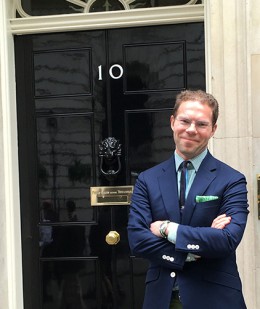
As Britain goes to the polls, I realized I forgot to mention I paid a visit to 10 Downing Street in April. I was invited by the Prime Minister’s deputy transport advisor and the Treasury’s transport policy team, who graciously hosted me in a wood-paneled conference room with more history than the entire West Wing. While I won’t divulge the details of what was a private meeting, I will say they’d read my report for the New Cities Foundation arguing for greater powers for public transport in a world of connected mobility. No matter what happens, I hope Britain’s government will make better choices about transport, cities, and equity than their U.S. counterparts.
June 07, 2017 | permalink
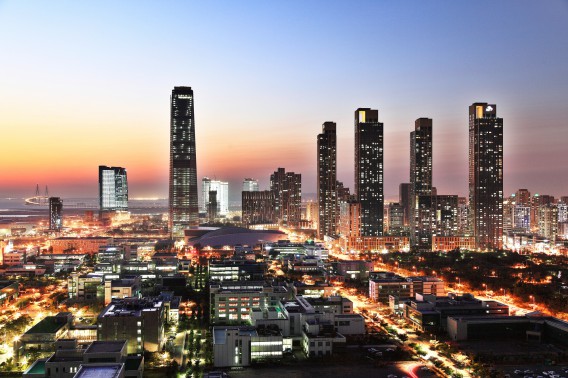
(I’m back in Songdo for the first time in years for the New Cities Summit, and by sheer coincidence, Travel + Leisure asked me to contribute a short piece on the city and the aerotropolis in general to accompany the photographs of Giulio di Sturco.)
A decade ago, visitors to the man-made South Korean island-city of Songdo, 40 miles outside Seoul, could stand on the site of a development projected to grow to the size of downtown Boston and find seashells still sticking out of ground that, until recently, had been underwater.
Just two years later, in 2009, Songdo’s American developers cut the ribbon on the $35-billion city, home to a Jack Nicklaus golf course and what was at the time South Korea’s tallest tower. Songdo’s defining feature, arguably, was less conspicuous: a 7.4-mile bridge connecting it with Incheon International Airport.
Songdo is an “aerotropolis,” a city built around an airport, specifically conceived to harness a transport hub’s global connections. Such places are designed to serve a class of 21st-century nomads who live to go everywhere. Typically, the aerotropolis is an amalgam of made-to-order offices, sleek convention centers, international chain hotels, malls teeming with global brands, sometimes even a theme park.
Aerotropolis is a faux-Greek term coined in China 25 years ago, and as an urban model it has achieved its fullest flowering in Asia. First came Hong Kong – where new towns and a Disneyland were built next to the $20 billion island airport – followed by Shanghai, Singapore, and Dubai, which will host Expo 2020 in an airport city larger than San Francisco.
Over the last five years, Italian photographer Giulio di Sturco, who shot the images on this page, has traveled throughout Asia documenting the aerotropolis phenomenon. “I’m pretty sure this is the new direction the world is taking,” he said. “These cities are in effect the cities of the future, so for me it is a way to see into the future right now.”
But will the aerotropolis ever be loved? If a prime reason for travel is to experience the distinctive terroir, culture, and history of a place, what’s the appeal of a city that is by definition transitory, designed to evoke nowhere?
Perhaps it is the chance to witness the real-time evolution of a place liberated from the past, living in the moment, and looking only toward the future – a future that looms into view like the planes above Songdo, dropping through the clouds on their final approach.
June 06, 2017 | permalink

(I’m currently the Urbanist-in-Residence at URBAN-X, the urban startup accelerator run by BMW MINI in conjunction with the venture capital firm Urban Us. This originally ran at Fast Company’s branded content arm FastCo.Works on May 31, 2017.)
Fourteen weeks after converging on Brooklyn, the eight startups of URBAN-X–a venture accelerator founded by MINI–had reached the moment of truth: Demo Day. Taking the stage in a Ghostbusters-style jumpsuit, Upcycles cofounder Daniel Wendlek channeled the accelerator’s spirit in a jeremiad against delivery drones.
“You know what? F%*&$ robots!” he said to wild applause. “Cities struggle as it is to provide space for one of our most vital resources–human beings.” His company’s alternative: an electric-assisted tricycle capable of 500-pound deliveries at a cost of only $.002 per mile.
And so it went for 40 minutes, a stream of pitches advocating for what Micah Kotch, URBAN-X managing director, had described in his introduction as “human-first design.” Whether it was Wendlek railing against robots, Contextere CEO Gabe Batstone promising to empower blue-collar workers through data (“I want to create Iron Man, not Skynet!”), or WearWorks CEO Keith Kirkland vowing that a blind runner would complete the New York City marathon using the company’s touch-sensitive Wayband, putting people at the center of urban tech was the theme of the evening.
While half the cohort celebrated people power, the other half underscored how urban tech is the right alternative when urban policies fail. Early on, O2-O2 CEO Dan Bowden highlighted the urgent use case for his company’s brand of air-filtration facewear by observing that 22 million residents of greater Beijing were at that moment trapped indoors by a sandstorm seven times smoggier than the average punishing day in the city.
RevMax’s Jonathan Weekley demonstrated how his company’s on-demand fleet-management software could boost the average utilization of taxis and ride-hailing vehicles from 50% to 74%–an absolute necessity when unchecked ride-hailing has added 600 million vehicle miles to New York City streets.
“We need to be thinking about what is going to change and benefit individual lives,” URBAN-X program director Miriam Roure said. “When technologies are implemented at an urban scale, we need to understand the socio-economic impact–direct and indirect–they could have. We don’t see disruption as necessarily positive.”
As Shawn Broderick, managing director of venture fund SOSV, noted earlier in the evening, “The big picture here is that cities are becoming more vital to everyone’s life choices. This is a megatrend that won’t stop in the next 5 or 10 or 20 years–this will last an entire century.”
For the hundreds of city residents crowded into the URBAN-X workshop and spilling out into the hall, it might have appeared the startup founders onstage had always known exactly what they were doing. But for those who were present at the beginning–the experts-in-residence, guest mentors, and especially the program directors–the progress was particularly sweet. Fourteen weeks ago, they had products and projects and prototypes in search of a business model. Tonight, they had the foundations of a viable, scalable company on their hands.
What else did each team receive in exchange for a small equity share in their startup, and where would they go from here? For one thing, graduation had appreciably increased their chances for funding. As many as one-third of all startups receiving Series A funding are veterans of accelerators, as investors look to gatekeepers such as Y Combinator and others who instill a rigor in founding teams and provide them the right connections for future growth. For another, they could tout their affiliation with one of the world’s leading brands: MINI.
As the founders of each team rushed to prepare their booths for hundreds of visitors and rehearsed their pitches one last time, a few shared their thoughts on what they learned. For Sencity cofounders Steven Bai and Ivan Chen, who moved to New York from Sydney, the program offered both personal introductions and technical validation. “Here in America,” said Bai, “we’re talking to municipalities” about their interactive trash can, the TetraBin. “As foreigners, why should they have conversations with us? Thanks to the program, there’s a basic layer of trust.”
Other teams learned important lessons about their potential customers and themselves. Upcycles cofounders Wendlek and Nick Wong entered the program unsure about whether they were bike manufacturers or a delivery service, for which they already had customers. They’re the former, they decided. “In the next few months, we’ll build five trikes for a pilot,” said Wong, “and figure out our manufacturing process so we can build 50 by the end of the year.”
Contextere’s Batstone didn’t need help from URBAN-X in learning how to build a startup, having run software companies for 15 years. But embedding in an urban tech accelerator did teach him that the company’s software, originally designed for military and energy customers, also has a powerful role to play in maintaining urban infrastructure, such as the electric grid. “We came here as an experiment, as someone not in the process of raising money,” Batstone said. “We knew that surrounding ourselves with a bunch of fledgling entrepreneurs would give us some of their energy–being around people who have that spark is worth it.”
For the rookies, the opposite proved true. Envairo’s Gabe Peschiera entered the program alone. He graduated with a team, potential customers, and several pilot projects to demonstrate the efficacy of his smart building software.
“The value of the program is not one thing, it’s everything,” he said. “Figuring out how to engage potential advisers. Learning how VCs think. How to use AngelList for recruiting. How to have conversations about equity with potential cofounders. And all with companies that share my values. They’re not just going to build tech to make advertising more clickable–they’re building stuff in the world they want to share. All of us are trying to solve real problems with real solutions.”
May 01, 2017 | permalink
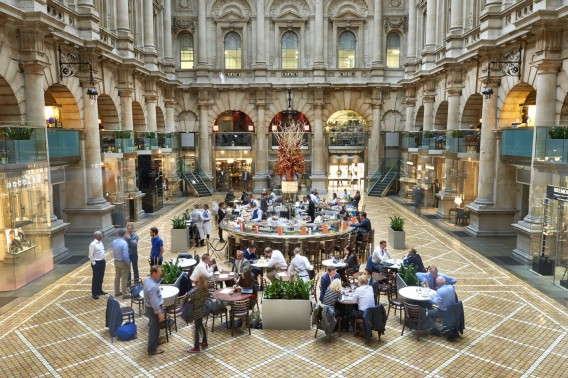
(Originally published at Medium on May 1, 2017.)
The Heron is blandly handsome as London skyscrapers go, compared to the nearby, and similarly whimsically nicknamed, “Gherkin,” “Walkie Talkie,” or “Cheesegrater” towers. But the three-year-old luxury building is exceptional in two respects. For one thing, it’s the first housing block since the 1970s to be located in the City, the compact, ancient financial center of London, also known as the Square Mile. For another, its few full-time residents include Peter Wynne Rees, who personally approved its construction – along, as it happens, with the Gherkin, Walkie Talkie, and Cheesegrater. As the longtime chief planner for the City of London Corporation, Rees is, arguably, the person most responsible for the stunning recent transformation of London’s historic core into one of the fastest growing centers of commercial development on the planet.
After a remarkably long tenure – nearly thirty years – Rees retired in 2014, but is still fiercely protective of what he calls “the engine room” – the economic hub of Greater London, the United Kingdom, and perhaps the world. (For now.) He’s been outspokenly critical of luxury apartments marketed to absentee owners who wire the funds from offshore accounts, notoriously describing such projects as “safety deposit boxes in the sky.” But on a recent tour of the district I discover he’s surprisingly skeptical of housing in general, given that most homes are empty during the day and dark at night. The City has neither the time nor the room for that.
“It’s a waste of land, which is in short supply here,” Rees tells me during our walk. “Cities can’t afford that degree of underuse.” He sees the City, above all, as a commercial reactor fueled by chance encounters and traded snippets of information – what he calls “the gossip.” Though accelerated by the financial deregulation in the 1980s, this heritage reaches back several centuries, starting with the founding of the Royal Exchange in 1571, spilling over into the Restoration-era pubs and coffee houses lining nearby Change Alley, and continuing to this day in the pocket parks and arcades he and his staff planned or protected. “People make places; places make gossip; gossip makes people money,” he explains. “And the City is especially well-designed to allow that to happen.”
May 01, 2017 | permalink

(I’m currently the the Fast Company Urbanist-in-Residence at URBAN-X, an urban tech accelerator in Brooklyn sponsored by BMW MINI and SOSV. The following dispatch covers “Where The Robot Meets The Road,” a public event on March 30th covering the intersection of autonomous vehicles, public policy, and infrastructure.)
Autonomous vehicles (“AVs”) are finally having their moment. On the cusp of becoming a reality, everyone from futurists to everyday drivers is talking about the promise of a new era in transportation, in which “drivers” can kick back and read a book, and collisions and accidents are vastly reduced.
And they may be correct. Done right, autonomous vehicles could indeed save many, if not most, of the 35,000 Americans killed in car crashes each year, reduce tailpipe emissions, and functionally extend mass transit into the suburbs with autonomous shuttles.
But without highly strategic planning and collaboration between the public and private sectors, they could just as easily produce traffic jams of empty vehicles, and bankrupted mass transit systems–increasing the gridlock that already plagues most modern cities instead of alleviating it.
Zipcar founder Robin Chase has described these scenarios as the “heaven or hell” of autonomous vehicles, arguing that heaven is only possible if cities and their citizens have an equal voice in guiding their introduction. The future of AVs is unquestionably urban–Bloomberg and McKinsey forecast that 70% of AVs sold in Europe and North America through 2030 will be in dense cities and their affluent suburbs.
To that end, last month URBAN-X–a venture accelerator founded by MINI– invited more than a hundred designers, policymakers, technologists, academics, and Brooklyn residents to its Greenpoint headquarters at A/D/O to debate the correct blend of innovation and regulation to set AVs in the right direction, and harness their true potential for the betterment of cities.
March 29, 2017 | permalink
I spent last Sunday night chatting with The Augmented City’s host and curator John du Pre Gauntt about cities, mobility, autonomous vehicles and public transport – a few of my favorite things, in other words. Please click on the link above to listen.
March 19, 2017 | permalink
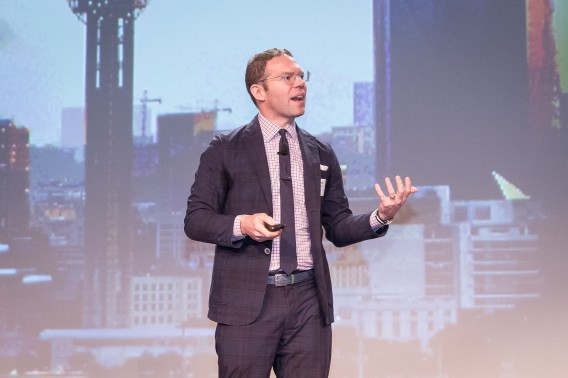
(Photo credit: Thomas Garza Photography.)
This year is shaping up to be my busiest yet in terms of speaking, moderating, and making public appearances, and this winter has been no exception. It’s been a whirlwind three months – and that’s on top of the birth of our second son, Whitaker Dow Lindsay, on New Year’s Day! As the calendar turns to spring, here’s a quick recap of my sleepless winter:
The year began with a day trip to Los Angeles to judge AECOM’s Urban SOS awards, organized in conjunction with the Van Alen Institute and Rockfeller Foundation. This year’s competition, titled “Fair Share,” required multidisciplinary student teams to submit proposals for “sharing economy” services that actually involved, you know, sharing. The winning submission from Washington University, “First Class Meal,” proposed repurposing underutilized United States Post Offices for local food storage and distribution. They received a cash prize of $7,500 and $25,000 worth of in-kind contributions from AECOM to realize their plan.
From there it was off to Abu Dhabi to speak at the World Future Energy Summit (pictured below), where I framed the challenges and opportunities in terms of what might be called George Gilder’s Second Law: “In every era, the winning companies are those that waste what is abundant in order to save what is scarce.” What does that mean for mobility in an era of autonomous electric vehicles wasting both abundant solar electrons and unpriced roads? How will they conserve the most valuable resource of all – our time?
One theme of the winter has been the unintended consequences of the Internet of Things. At the launch festival for BMW MINI’s new Brooklyn workshop, A/D/O – where I’m the Urbanist-in-Residence at its in-house startup accelerator, URBAN-X – I interviewed MIT roboticist Kate Darling on robots and empathy, and tortured her pet dinosaur on stage (pictured below). A few weeks later, Changeist’s Susan Cox-Smith hosted a private workshop and public event at A/D/O exploring the ramifications of the IoT (Internet of Trump). And the week after that, I was in Chicago, warning of the perils of Big Data and the IoT at the IC Bus Innovation Summit – because really, what can go wrong with an Internet-connected school bus?
The remainder of my talks – for the commercial real estate investment group Accesso Partners, the independent commercial broker associations CORFAC and CORE Network, and the annual luncheon of Downtown Dallas Inc. – focused on how cities are moving away from single-use suburban malls and office parks toward shared workspaces, renewed public spaces, and a new mobility paradigm to support them. It’s a theme that will resonate a lot this spring in upcoming talks and workshops in New York and Oslo on autonomous vehicles. More soon.
March 18, 2017 | permalink
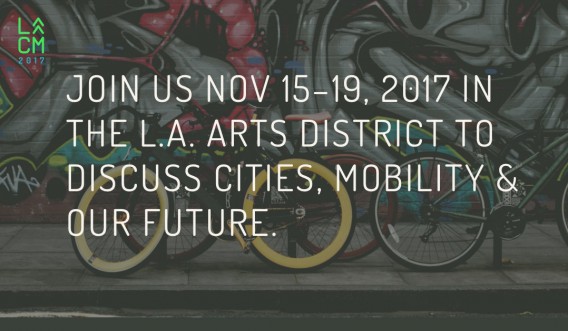
Building off my work for the New Cities Foundation last year – specifically my report “Now Arriving: A Connected Mobility Roadmap for Public Transport” – I’m pleased to join the foundation’s inaugural new mobility festival, LA CoMotion, as its director of strategy.
Scheduled to take place November 15-19, 2017 in the Arts District of Los Angeles, LA CoMotion is arguably the first of its kind in the United States, a five-day event focused as much on how we live, work, and play – not to mention walk, bike, and ride – as it is on vehicles and technology. Global VIPs and Angelenos alike will be invited to create the future together in the streets of Downtown LA in conjunction with our partners, including LADOT, Gensler, Piaggio Fast Forward, Project for Public Spaces, UITP and many more to come.
My job, I’m excited to say, is to curate the collaboration among our sponsors and partners to create an event that doesn’t devolve into a World’s Fair-like spectacle of a future perpetually just over the horizon, but contains the germ of a new future for Los Angeles and cities around the globe. I hope you’ll help us – please visit the site to request an invitation, or join us as a partner.
March 17, 2017 | permalink

Anyone who follows me on LinkedIn knows I have a fondness for collecting titles, but my latest may be my favorite: the Fast Company Urbanist-in-Residence at URBAN-X. It requires some explaining.
URBAN-X is a startup accelerator for nascent companies with an urban bent, whether that has to do with mobility, real estate, pollution, trash, or wayfinding for the blind. The accelerator is a joint venture between SOSV – the world’s largest accelerator program with hundreds of graduating startups per year, like scratch-and-win lottery tickets – and BWM MINI, which houses the program in its Brooklyn combination restaurant/co-working/makerspace, A/D/O. Why MINI? Because BMW executives realized the Mini Cooper’s brand equity is greater than the car – hence the effort to transform it into a lifestyle brand comprised of MINI Living, MINI Fashion, and more. (Presumably, we can one day expect to live in a global MINI-branded co-living chain equipped with cars from ReachNow, BMW’s American car-sharing program.
My role is the result of a deal between Fast Company and URBAN-X to advise the startups-in-residence on the peculiarities of cities and file dispatches on their progress. (Pre-seed round startups, I’ve learned, are a lot like toddlers – they constantly grasp at the nearest, shiniest thing.) In the meantime, TechRepublic has a nice round-up of the eight startups in the current cohort, three of which have “sense” in their name.
I’ve also agree to host or participate in several events at A/D/O this spring, including the kickoff festival in Janaury, last month’s “The Internet of Very Bad, No-Good Things,” and next month’s event with The Kingdom of Happiness author Aimee Groth on April 3rd.
Next up is “Where The Robot Meets The Road” on March 30:
Where The Robot Meets The Road
The rise of Uber and advent of autonomous vehicles herald a new era in urban mobility while threatening to disrupt public transport infrastructure. How can cities reconcile these competing models while preserving the public interest?The format of this event will be a participatory panel discussion led by our Urbanist-in-Residence Greg Lindsay, in conversation with:
• Zack Wasserman, Head of Global Business Development at Via On-Demand Transit.
• Corinne Kisner, Director of Policy and Special Projects at NACTO.
• Varun Adibhatla, Founder of ARGO and Adjunct Instructor at NYU’s CUSP.This event is our kickoff event of our monthly URBAN-X Dialogue Series. During these events we will hold off-the-record, participatory conversations to discuss critical questions around the impact of urban technologies in our lives. We believe that dialogue is a fundamental element for understanding the complexity of our diverse personal universes, and the starting point of better solutions for a brighter urban life.
And yes, there will be beer. Please register here; I hope to see you there.

» Folllow me on Twitter.
» Email me.
» See upcoming events.

Greg Lindsay is a generalist, urbanist, futurist, and speaker. He is a non-resident senior fellow of the Arizona State University Threatcasting Lab, a non-resident senior fellow of MIT’s Future Urban Collectives Lab, and a non-resident senior fellow of the Atlantic Council’s Scowcroft Strategy Initiative. He was the founding chief communications officer of Climate Alpha and remains a senior advisor. Previously, he was an urban tech fellow at Cornell Tech’s Jacobs Institute, where he explored the implications of AI and augmented reality at urban scale.

----- | January 22, 2024
The Future of Generative AI in Architecture, Engineering, and Construction
----- | January 1, 2024
----- | August 3, 2023
CityLab | June 12, 2023
Augmented Reality Is Coming for Cities
CityLab | April 25, 2023
The Line Is Blurring Between Remote Workers and Tourists
CityLab | December 7, 2021
The Dark Side of 15-Minute Grocery Delivery
Fast Company | June 2021
Why the Great Lakes need to be the center of our climate strategy
Fast Company | March 2020
How to design a smart city that’s built on empowerment–not corporate surveillance
URBAN-X | December 2019
CityLab | December 10, 2018
The State of Play: Connected Mobility in San Francisco, Boston, and Detroit
Harvard Business Review | September 24, 2018
Why Companies Are Creating Their Own Coworking Spaces
CityLab | July 2018
The State of Play: Connected Mobility + U.S. Cities
Medium | May 1, 2017
Fast Company | January 19, 2017
The Collaboration Software That’s Rejuvenating The Young Global Leaders Of Davos
The Guardian | January 13, 2017
What If Uber Kills Public Transport Instead of Cars
Backchannel | January 4, 2017
The Office of the Future Is… an Office
New Cities Foundation | October 2016
Now Arriving: A Connected Mobility Roadmap for Public Transport
Inc. | October 2016
Why Every Business Should Start in a Co-Working Space
Popular Mechanics | May 11, 2016
Can the World’s Worst Traffic Problem Be Solved?
The New Republic | January/February 2016

January 31, 2024
Unfrozen: Domo Arigatou, “Mike 2.0”
January 22, 2024
The Future of Generative AI in Architecture, Engineering, and Construction
January 18, 2024
The Promise and Perils of the Augmented City
January 13, 2024